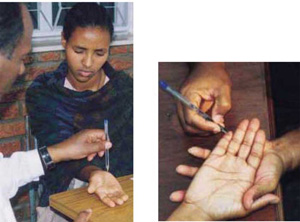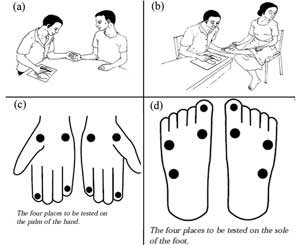18.4.3 Examination of hands and feet for loss of sensation
The sensation test (ST) is an examination to test sensation in the hands, served by the ulnar and median nerves, and also in the feet.
Your aim is to compare the sensation in the little finger with that of the thumb, and the sensation of one hand with the other, to see if there is any difference. Then repeat the test on the feet. If you have done these tests on the same person previously, compare the findings with those shown on any earlier records.
Before you start the test, make a note of any wounds or cracks or bone loss on the hands/feet.
First, support the person’s hand or foot so that fingers/toes are well supported to prevent joint movement during the test (see Figure 18.6).

Make sure you get hold of a Record Card for a leprosy patient and spend time looking at it. On it, you can record all the important details that relate to the patient, such as the skin lesions you can see, the results of palpation and the outcomes of the voluntary muscle tests you will perform.
Explain the test to the person and rehearse it with him/her with eyes open. Then perform the test (described below) with the person’s eyes closed. A book or another suitable object can be held in front of the eyes, so that the person cannot see.
Use the point of a ballpoint pen (biro) to dent the person’s skin to a depth of 1–2 mm at the four test points (dots) on the palm of the hand (Figure 18.7a and c).
Do not allow the pen tip to slide across the skin – press it straight down and lift it straight up again. Ask the person to point to the exact site whenever he/she feels the pressure from the pen – first the ‘rehearsal’ with eyes open, and then with eyes closed. The test points should be pressed at irregular intervals and each test point should be chosen at random – don’t test them in a fixed pattern, so that the person can’t guess where you will test next. Avoid repetitive testing at any one test point. Provide time for a response: older people may need a little more time to respond.
Repeat this process at four test points (dots) on the feet (Figure 18.7b and d).

Record the results in a leprosy patient record card, or mark the results on suitable diagrams of the type shown in Figure 18.7(c) and (d). On a record card, mark ✓ if the person feels the pressure at a particular test point, or X if he/she does not feel it.
Where possible, compare your findings with those shown on any earlier records – look for differences over time. Make sure that the change is real and not simply a result of one or other of the tests having been recorded in a careless and therefore inaccurate way.
18.4.2 Examination/palpation of the peripheral nerves
